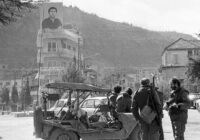After protests at the beginning of 2018, Iran faces more questions than answers over its future.
The protests in Iran earlier this year were the largest anti-government demonstrations since the 2009 Green Movement. International media outlets, especially American and European, drew on the fact that the main cause behind the unrest was socioeconomic-related. The situation, however, was more complicated than this.
The demonstrations, which began at the end of 2017 and escalated in January, could be compared with the May 1968 movement in France. That year, the world reacted to US actions during the Vietnam War. But the movement did not merely focus on the US and its policies in Vietnam. Rather, it included other socioeconomic issues and debates over the lives of citizens, including capitalism and LGBT and workers’ rights. The main grievance of French students participating in protests was their opposition to the hierarchy in the French social system and the low quality of workers’ lives. This was also the case with the protests in Iran.
Observers considered the May 68 movement as a protest against the “old social system” and the demand for more political and social liberties. This movement crystallized the demonstrations against “conservatism” of the 1960s — conservatism that was a feature of both the Charles de Gaulle government and the opposition party.
Similarly, conservatism in Iran dominates politics. Hassan Rouhani, the incumbent president, was a former student of President Hashemi Rafsanjani. Under Rafsanjani, Rouhani was one of the highest security figures in Iran and close to the right wing. However, when he campaigned for the presidential election in 2013, reformists were forced to support the Rouhani campaign and his slogan of “moderation” because of the many constraints within the Iranian political system for any activity after the 2009 Green Movement.
But Rouhani’s government record shows that his main objective is not only focused on the political and social space — contrary to his electoral promises — but also privatization and the adoption of neoliberalism. This can be seen in the reduction of welfare and social budgets, and the removal of a large part of a supportive subsidy, which, among other things, covers the price of oil.
Young Iranians
Another issue is the generation gap in Iran. The average age of cabinet members in the first Rouhani government was 58, while the current administration is equally high. Most decision-makers in government bodies are elderly, despite more than 60% of the population being under 30. As of 2017, the unemployment rate of the total labor force was 11.4%, while youth unemployment is substantially higher. There is also a low chance of unemployed youth getting a public sector job, meaning the private sector cannot cope with the number of applicants. This has many different reasons ranging from ideology — those aligned with the 1979 revolution are often favored — to nepotism.
Youth in Iran are tech-savvy and are well connected on social networks. Despite the official ban on satellite in Iran, many Iranian citizens have access to foreign TV networks. Young Iranians also download and watch the latest American TV shows on the internet. Just by looking at customers at Iranian cafes, you can see that the youth like the Western and secular lifestyle.
As a result, there is a contradiction between their desire for greater freedom and the dominant conservative ideology that relies on traditional and patriarchal values. The presence of an Iranian woman in Enqelab Square holding her white headscarf in the recent protests — as a stand against forced veiling — clearly shows that a significant number of Iranians are demanding the freedom to choose what they wear.
The image of this woman resembled those of the rebellious youth of Paris in May 1968. One of the catalysts behind the movement in France was a protest against gender policies at university, which gradually became wider and more radical, and it soon questioned the foundations of the family, patriarchy and capitalism. The issue of gender segregation in the subway, buses and public life also exists in today’s Iran.
One of the reasons that prolonged the protests of May 68 was the Algerian War of Independence in the 1950s. In Iran, slogans used in the recent protests asked the government to be held accountable for getting involved in regional affairs, especially the Syrian and Yemeni wars, and also funding militias in the Middle East.
The Bourgeoisie of Paris and Tehran
An interesting point was the common reaction of the opposition to both the French and Iranian protests.
In May 68, the bourgeois movement and the main left-wing party in France opposed the demonstrations and followed the status quo. At that time, communists opposed the rebellion and collaborated with the government because the students protested against the policies of the party and the Soviet Union. At the time, L’Humanité, a newspaper of the French communist party, was full of criticism against the student demonstrators: the affluent, petty bourgeoisie, the working-class enemies and the adventurous Trotskyist leftists.
During the protests in Iran, the capital’s bourgeoisie in Tehran — who mostly voted for Rouhani in last year’s elections and believed in reforms within the system — didn’t participate in the demonstrations. Most protesters who took to the streets in other Iranian cities generally consisted of unemployed youth and workers who received no salary for months. In Iran, the reformist camp also played the role of their French counterparts on the left. They were worried about the spread of protests.
Abbas Abdi, a well-known reformist figure, criticized the passivity of protesters and called for “a sharp crackdown on the rioters.” Hamid Reza Jalaeipour, another well-known individual among reformists, also called for a crackdown on the protesters and dubbed them “the overthrown-demanding vultures.” He also pointed out that the integrity of the political system in Iran should be defended and supported. Other reformists condemned the unrest and believed that it was planned by foreigners and supporters of the shah.
The May 68 movement was influential in many respects despite not leading to a revolution. After the movement died down, capitalism was forced to award privileges. The liberties that the French rebels had demanded have since become a reality in Western societies: lifestyles have changed, individualism is not questioned and there is a no limit for enjoyment. But neoliberalism rules the day when it comes to the economic system and inequality has intensified. The ideal of equality that protesters in May 1968 held has failed to materialize.
Will Iran enact serious changes in the political, social and economic systems as a result of the protests? Will the present political system grant citizens both social and individual freedoms? The answers to these questions are unknown, but it is these answers that will determine the future prospects of the country.
*[Updated: May 8, 2018, at 23:30 GMT.]
The views expressed in this article are the author’s own and do not necessarily reflect Fair Observer’s editorial policy.
Photo Credit: Sergsta / Shutterstock.com
Support Fair Observer
We rely on your support for our independence, diversity and quality.
For more than 10 years, Fair Observer has been free, fair and independent. No billionaire owns us, no advertisers control us. We are a reader-supported nonprofit. Unlike many other publications, we keep our content free for readers regardless of where they live or whether they can afford to pay. We have no paywalls and no ads.
In the post-truth era of fake news, echo chambers and filter bubbles, we publish a plurality of perspectives from around the world. Anyone can publish with us, but everyone goes through a rigorous editorial process. So, you get fact-checked, well-reasoned content instead of noise.
We publish 2,500+ voices from 90+ countries. We also conduct education and training programs
on subjects ranging from digital media and journalism to writing and critical thinking. This
doesn’t come cheap. Servers, editors, trainers and web developers cost
money.
Please consider supporting us on a regular basis as a recurring donor or a
sustaining member.
Will you support FO’s journalism?
We rely on your support for our independence, diversity and quality.






